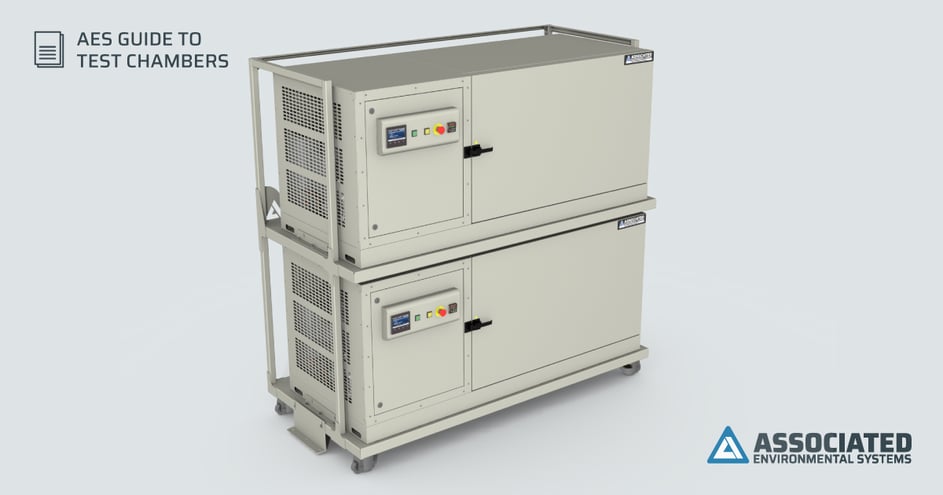Learn More About AES Benchtop Test Chambers
What are your testing needs? Whether you’re in the aerospace industry or the consumer electronics industry, a benchtop chamber could be an ideal testing solution. Their compact size allows companies to optimize their lab space and test smaller components efficiently and effectively.
As you consider which environmental chamber is right for you, learn more about benchtop chambers and how specifically Associated Environmental Systems (AES) can help. Benchtop chambers offer more than just convenience.
What Are Benchtop Chambers?
Benchtop chambers are known for their flexible and accommodating features. They are designed to sit on easy-to-access shelves and tables or can be stacked to double or triple-floor space in your lab. Their internal volume typically includes up to 1 to 13 cubic feet of space, allowing your devices under testing (DUTs) or smaller components to be tested adeptly.
These efficient chambers can be used for a variety of functions. Across industries, they can be applied for the following:
Battery Testing
Battery Testing is essential for determining the safety and durability of batteries, EV and consumer electronics companies often turn to benchtop chambers for battery testing needs. Not only do they ensure all products perform as expected, but they also can be used to conduct research, develop technologies, and condition batteries.
Temperature Cycling
Within the aerospace industry, companies often need to assess a product, material, or component's durability and breaking point. Benchtop chambers allow these companies to complete temperature cycling and gradually alternate between high and low temperatures to avoid unforeseen mechanical or manufacturing failures.
Stability Testing
Pharmaceutical companies often need to determine how well their products will remain safe and functional while stored on a shelf or in certain environmental conditions. Benchtop chambers, capable of stability testing, pave the way for top pharma companies to effectively test the durability of products and the accompanying packaging.
Benchtop chambers can also be used for a wide variety of product testing, and are available in temperature-only chambers, humidity chambers, laboratory and liquid-cooled ovens, and salt spray chambers. Their versatility truly sets them apart.
Benchtop Humidity Chamber vs. Temperature-Only Chambers
While benchtop environmental test chambers are available in multiple models, they’re most commonly used as humidity or temperature chambers. A standard benchtop humidity chamber can cost around $14,700, while a temperature-only chamber starts at just under $14,000 for the smallest models.
Both models have similar workspace volumes ranging from 1.01 to 12.95 cubic feet and accommodate temperatures ranging from -37°C to 180°C (-34.6°F to 356°F). Apart from the 500 series with single-stage refrigeration, AES additionally offers a 200 series with cascade refrigeration that lowers the temperature to -70°C. While both temperature-only and humidity chambers utilize vapor generator systems to give you precise control over conditions, a benchtop temperature chamber specifically can achieve controlled temperatures facilitated by open ceramic-core nichrome heaters and a self-contained, compact, mechanical, single-stage refrigeration cooling or cascade refrigeration system.
Humidity chambers also have the unique ability to expand the standard 95% RH humidity range with optional features. High humidity sensors with added options enable you to control humidity conditions up to 98% RH, while you can reach extremely dry air conditions with nitrogen purges, dry-air purges through a desiccant air dryer, or a recirculating desiccant air dryer. Certain benchtop humidity chambers, such as the LH Series, are also designed with steady-state testing in mind. Other models enable high-performance testing or cycling. The SCH Series (temperature and humidity) and SC series, which feature the world's most powerful benchtop humidity and temperature-only chambers due to their rise and pull-down rate of 5°C per minute, can be optimized for battery testing. It is designed to integrate with battery testing fixtures, including high-amperage batteries EVs require. In summary, stackability within battery testing adds high levels of versatility since each chamber can run different tests independently with various temperatures, test profiles, and more.
The Benefits of Benchtop Environmental Test Chambers
Regardless of your desired chamber model, the benefits of benchtop chambers are exceptional. Because of their smaller footprint and stackability, benchtop chambers offer room for controlled expansion. Should you expect your testing requirements to increase significantly over a multi-year period, rather than purchasing a separate larger chamber, spend less on a benchtop environmental chamber and stack it as needed. This efficiency proves the benchtop chamber valuable. You can maintain smaller chambers and complete the same amount of testing in a smaller footprint. Should any issues arise during testing in one chamber, you can easily isolate incidents and return to testing without having to retest as many devices under testing (DUTs).
Optimizing lab space can be a challenge. With a benchtop chamber from AES, though, you’re able to run several different tests using the same amount of floor space. Our benchtop chambers are designed to fit up to three chambers high so you can triple your workspace volume, giving you the necessary space to account for performance, employee movement, power requirements, and more. You can even collaborate with our team to improve your lab design. We’ll consult you on the best approach to maximizing your floor space, planning for future expansions, taking the proper safety measures, and more.
Which Testing Chamber Will It Be?
We’re here to bring you advanced testing solutions. Whether you’re interested in benchtop chambers for battery testing or product testing, you can rely on us to meet your needs. Share your next big idea with an AES sales engineer today.




